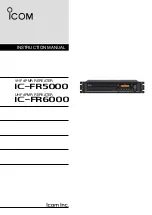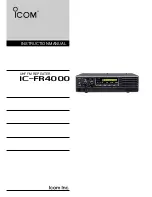
LP-314 Rev. 012 Rel. 003 Date 9.27.19
24
Description
Stock Code
2” PVC Concentric Termination Kit
KGAVT0501CVT
3” PVC Concentric Termination Kit
KGAVT0601CVT
2” Stainless Steel Termination Kit
V500
3” Stainless Steel Termination Kit
V1000
4” Stainless Steel Termination Kit
V2000
3” Polypro Vent Kit
8400P-001
Table 9 - Optional Vent Kits
lots. Condensate could drip and freeze, resulting in a slip hazard or
damage to vehicles and machinery.
9. Due to potential moisture build-up, sidewall venting may not be
the preferred venting option. To save time and cost, carefully consider
venting installation and location.
10. Horizontal lengths of exhaust vent must slope back towards the
appliance not less than ¼” per foot to allow condensate to drain from
the vent pipe.
11. The exhaust vent must terminate where vapors cannot make
accidental contact with people or pets, or damage air conditioners,
shrubs, or other plants or objects.
12. DO NOT vent the appliance in a chimney flue serving a separate
appliance designed to burn solid fuel. The appliance may only be
vented in vacant chimneys. In vacant chimney applications, install and
seal a rain cap over existing chimney openings.
13. All piping must be fully supported. Use pipe hangers at a minimum
of 4 foot intervals to prevent sagging of the pipe where condensate
may form.
14. Do not use the heater to support any piping.
15. A screened straight coupling is provided with the heater for use as
an outside exhaust termination.
16. A screened inlet air tee is provided with the heater to be used as an
outside intake termination.
17. Maximum Snow Level Determination: These installation
instructions reference snow levels in establishing a minimum height
for the installation of exhaust vent or air intake terminations. Snow
levels shall be determined as follows:
a. The installation location may, by ordinance, designate how snow
levels are calculated in that location; or
b. In the absence of specific ordinances, snow levels shall be calculated
from the average monthly maximum depth of snow accumulation as
indicated by the National Weather Service’s 10 year statistics for the
installation location/geographical area.
In addition:
•
Total length of vent piping shall not exceed the limits specified
in this manual.
•
The vent piping for this direct vented appliance is approved for
zero clearance to combustible construction.
•
The flue products coming from the exhaust vent will create a
large plume when the heater is in operation. Avoid venting in
areas that will affect neighboring buildings or be considered
objectionable.
•
DO NOT locate exhaust vent or intake pipe in a parking area
where machinery may damage the pipe.
•
DO NOT vent near soffit vents, crawl space vents, or other areas
where condensate or vapor could create a nuisance or hazard or
cause property damage.
•
DO NOT vent where condensate vapor could cause damage or
could be detrimental to the operation of regulators, relief valve,
or other equipment.
In the Commonwealth of Massachusetts and as Required by State
and Local Codes:
The vented gas fueled appliance shall not be installed so its combustion,
ventilation, or dilution air is obtained from a bedroom or bathroom.
Signage: Whenever any through-the-wall (horizontal or sidewall) vent
is installed less than seven feet above the finished grade, a metal or
plastic identification plate shall be permanently mounted to the
exterior of the building at a minimum height of eight feet above grade
directly in line with the exhaust vent terminal. The sign shall read, in
print no less than 0.5 inches in size, “GAS VENT DIRECTLY BELOW. KEEP
CLEAR OF ALL OBSTRUCTIONS”.
Marking of Exhaust Vent and Intake Pipe: Piping used for ventilation,
make-up, or combustion air intake shall be labeled as follows:
a. Throughout the entire developed length:
i. Labels must be placed every ten feet for exposed/visible piping; or
ii. Labels must be placed every three feet for concealed piping.
b. At all changes of direction;
H. Applications
1. Direct Vent Installation of Exhaust and Intake
If installing a direct vent option, combustion air must be drawn
from the outdoors directly into the appliance intake, and exhaust
must terminate outside. There are three basic direct vent options
detailed in this manual: 1. Side Wall Venting, 2. Roof Venting, and 3.
Unbalanced Venting.
Be sure to locate the appliance such that the exhaust vent and intake
pipe can be routed through the building and properly terminated.
Different vent terminals can be used to simplify and eliminate
multiple penetrations in the building structure (see Optional
Equipment in Venting Section). The exhaust vent and intake pipe
lengths, routing and termination methods must all comply with the
methods and limits given in the Venting section of this manual.
When installing a combustion air intake from outdoors, care must be
taken to utilize uncontaminated combustion air.
NOTE:
To prevent
combustion air contamination, see Table 2.
c. On each side of a penetration through a partition, wall or ceiling;
and
d. The labels shall be black lettering that:
i. Indicates that the piping is used for ventilation, make-up, or
combustion air intake, and
ii. The letters shall be sized equal to a minimum of the pipe
diameter. However, for piping with a diameter exceeding two
inches, said lettering does not need to be larger than two inches.
The following table lists optional exhaust/intake terminations
available from HTP:
















































